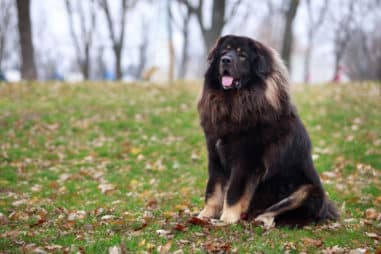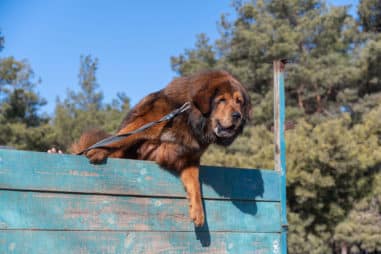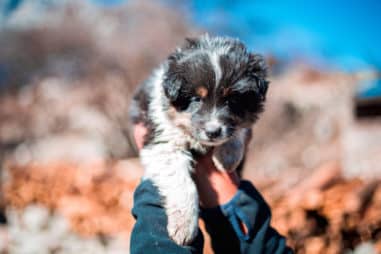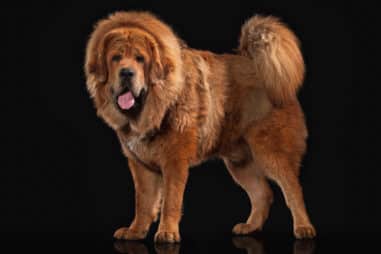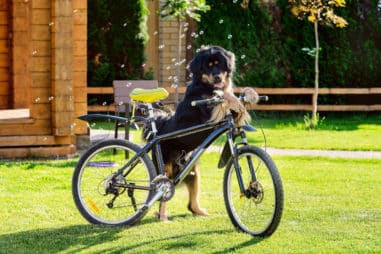Tibetan Mastiffs came from the high altitudes of the East. They have survived the cold through their winter coats. You can’t underestimate their resilience because they can also survive in the warmer parts of the globe.
Their bodies can adjust to different temperatures because of their coats. The undercoat goes through a seasonal shed as a way of cooling off. When the winter season comes around, the coat grows back to protect them from the cold.
Can Tibetan Mastiffs Handle Cold Weather?
As natives of the Himalayan mountains, Tibetan Mastiffs can handle cold weather. Their double coats keep them warm and protected from low temperatures. The harsh condition in their homeland has taught them to become remarkably tough.
Taking them out during the winter season is not a problem because they can handle the cold. If they’re in a place where the weather is warm, they can also adapt. Their coats shed the excess fur to keep them cool in warmer climates.
How Cold Is Too Cold for a Tibetan Mastiff?
Tibetan Mastiffs are tough dogs that can tolerate cold temperatures that humans cannot. But like any mortals on this earth, they do have limitations. They can endure 45°F to 32°F (7.22°C to 0°C) of cold.
Anything below 20°F (-6.66°C) is dangerous for all dog breeds. This low temperature can result in hypothermia. Even though they can endure the cold, it is best to let them stay inside during the winter.
Can Tibetan Mastiffs Go Out in the Snow?
Tibetan Mastiffs don’t have any problems going out in the snow. Their undercoat grows and thickens to protect the body from the cold. Similar to the Siberian Husky, a Tibetan Mastiff wouldn’t mind the winter.
If you want to play around in the snow with your dog, go ahead and have fun. Just make sure that the temperature outside doesn’t pose the risk of getting hypothermia. As tough as they are, the coat’s insulation can only do so much.
Do Tibetan Mastiffs Get Cold Easily?
Your Tibetan Mastiff can live comfortably in the cold. This is because of his weather-resistant coat that gives warmth. The insulation helps in regulating his body temperature.
Tibetan Mastiffs came from the cold region of Asia. The low temperature doesn’t bother them. The thickness of their winter coats protects them from the shiver-inducing cold.
How to Keep Tibetan Mastiffs Warm?
Despite having strong protection from the cold, your Tibetan Mastiff may need some additional warmth. If he’s comfortable with clothes, putting on some dry and thick clothing will help. A little bit of exercise can also generate body heat so playtime sounds good.
Don’t let him stay outdoors for too long when the temperature goes below the limit. Going back indoors, find a dry, soft, and warm surface where he can rest. He can skip some baths during the cold season to avoid frostbite and hypothermia.
How Do Tibetan Mastiffs Handle Heat?
Tibetan Mastiffs will shed their winter coats when the temperature starts rising. Their weather-resistant coats help them adjust to the changing seasons. While the winter coat gives insulation, shedding keeps them cool.
A thinner, well-maintained coat helps your Tibetan Mastiff deal with the heat. Bathing, brushing, and trimming make the scorching heat a bit more bearable. Grooming is essential, especially during the warmer months.
What Temperature Is Too Hot for a Tibetan Mastiff?
Dogs have higher body temperatures than humans. Tibetan Mastiffs have weather-resistant coats but the risk of a heat stroke is still there. If the temperature outside exceeds the 90°F (32.2°C) limit, this could threaten a dog’s health.
The safer temperature is around 75°F (23.9°C). Even though Tibetan Mastiffs are resilient, age is a factor to be considered. Puppies and aging Mastiffs are more vulnerable and sensitive to temperatures.
How Do I Keep My Tibetan Mastiff Cool?
Your Tibetan Mastiff will start to shed at the start or in the middle of spring. Brush his coat to remove the loose strands of hair. This is to let air pass through his coat for cooling.
Some trimming would be great as well. When you’re done brushing and trimming his coat, complete the process with a cool bath. Wipe him dry with a towel or you can use a blow dryer to make drying easier.
It’s better to let him stay indoors to prevent dehydration and heatstroke. Having an air conditioner is an advantage. Set the thermostat to 75°F (23.9°C) and lead him to a comfortable spot in your room.
Why Does My Tibetan Mastiff Like the Sun?
A decent amount of sunlight is very enticing for dogs. It’s a great source of vitamin D and the warmth makes them feel relaxed. If your Tibetan Mastiff is sunbathing in the morning, don’t fret.
He’s just enjoying a good dose of warmth and vitamin D. Because of his weather-resistant coat, a little bit of heat won’t be a problem. The midday sun is hotter so it’s better to let him stay indoors during this time.


